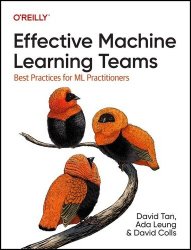Effective Machine Learning Teams: Best Practices for Ml Practitioners (Final)
- Добавил: literator
- Дата: 13-03-2024, 06:32
- Комментариев: 0
 Название: Effective Machine Learning Teams: Best Practices for Ml Practitioners (Final)
Название: Effective Machine Learning Teams: Best Practices for Ml Practitioners (Final)Автор: David Tan, Ada Leung, David Colls
Издательство: O’Reilly Media, Inc.
Год: 2024
Страниц: 402
Язык: английский
Формат: pdf (true), epub (true)
Размер: 15.1 MB, 10.1 MB
Gain the valuable skills and techniques you need to accelerate the delivery of machine learning solutions. With this practical guide, data scientists, ML engineers, and their leaders will learn how to bridge the gap between data science and Lean product delivery in a practical and simple way. David Tan, Ada Leung, and Dave Colls show you how to apply time-tested software engineering skills and Lean product delivery practices to reduce toil and waste, shorten feedback loops, and improve your team's flow when building ML systems and products.
Based on the authors' experience across multiple real-world data and ML projects, the proven techniques in this book will help your team avoid common traps in the ML world, so you can iterate and scale more quickly and reliably. You'll learn how to overcome friction and experience flow when delivering ML solutions.
You'll also learn how to:
• Write automated tests for ML systems, containerize development environments, and refactor problematic codebases
• Apply MLOps and CI/CD practices to accelerate experimentation cycles and improve reliability of ML solutions
• Apply Lean delivery and product practices to improve your odds of building the right product for your users
• Identify suitable team structures and intra- and inter-team collaboration techniques to enable fast flow, reduce cognitive load, and scale ML within your organization
Who This Book Is For:
Whether you’re a ML practitioner in academia, an enterprise, a start-up, a scale-up, or consulting, the principles and practices in this book can help you and your team become more effective in delivering ML solutions. In line with the cross-functional nature of ML delivery techniques that we detail in this book, we address the concerns and aspirations of multiple roles in teams doing ML:
Data scientists and ML engineers
The job scope of a data scientist has evolved over the past few years. Instead of purely focusing on modeling techniques and data analysis, we’re seeing expectations (implicit or explicit) that one needs to possess the capabilities of a full-stack data scientist: data wrangling, ML engineering, MLOps, and business case formulation, among others. This book elaborates on the capabilities necessary for data scientists and ML engineers to design and deliver ML solutions in the real world.
In the past, we’ve presented the principles, practices, and hands-on exercises in this book to data scientists, ML engineers, PhD students, software engineers, quality analysts, and product managers, and we’ve consistently received positive feedback. The ML practitioners we’ve worked with in the industry have said that they benefited from improvement in feedback cycles, flow, and reliability that comes from practices such as automated testing and refactoring. Our takeaway is that there is a desire from the ML community to learn these skills and practices, and this is our attempt to scale the sharing of this knowledge.
Software engineers, infrastructure and platform engineers, architects
When we run workshops on the topics we cover in this book, we often come across software engineers, infrastructure and platform engineers, and architects working in the ML space. While capabilities from the software world (e.g., infrastructure-as-code, deployment automation, automated testing) are necessary in designing and delivering ML solutions in the real world, they are also insufficient. To build reliable ML solutions, we need to widen the software lens and look at other principles and practices—such as ML model tests, dual-track delivery, continuous discovery, and ML governance—to handle challenges that are unique to ML.
Product managers, delivery managers, engineering managers
We set ourselves up for failure if we think that we need only data scientists and ML engineers to build an ML product. In contrast, our experience tells us that teams are most effective when they are cross-functional and equipped with the necessary ML, data, engineering, product, and delivery capabilities.
Скачать Effective Machine Learning Teams: Best Practices for Ml Practitioners (Final)
True PDF:
True ePub:
Внимание
Уважаемый посетитель, Вы зашли на сайт как незарегистрированный пользователь.
Мы рекомендуем Вам зарегистрироваться либо войти на сайт под своим именем.
Уважаемый посетитель, Вы зашли на сайт как незарегистрированный пользователь.
Мы рекомендуем Вам зарегистрироваться либо войти на сайт под своим именем.
Информация
Посетители, находящиеся в группе Гости, не могут оставлять комментарии к данной публикации.
Посетители, находящиеся в группе Гости, не могут оставлять комментарии к данной публикации.
